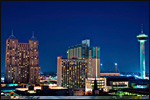
About:
San Antonio is the seventh most populous city in the United States of America and the second most populous city in the state of Texas, with a population of 1,409,019.[1] It was the fastest growing of the top 10 largest cities in the United States from 2000-2010, and the second from 1990-2000.[4][5] The city is located in the American Southwest, the south–central part of Texas, and the southwestern corner of an urban region known as the Texas Triangle.
San Antonio serves as the seat of Bexar County. San Antonio is the center of the San Antonio–New Braunfels Metropolitan Statistical Area. Commonly referred to as Greater San Antonio, the San Antonio-New Braunfels metropolitan area has a population of over 2.27 million based on the 2013 U.S. Census estimate, making it the 25th-largest metropolitan area in the United States and third-largest in the state of Texas. Growth along the Interstate 35 and Interstate 10 corridors to the north, west and east make it likely that the metropolitan area will continue to expand.
San Antonio was named for Saint Anthony of Padua, is notable for Spanish colonial missions, the Alamo, the River Walk, the Tower of the Americas, the Alamo Bowl, and Marriage Island. Commercial entertainment includes SeaWorld and Six Flags Fiesta Texas theme parks, and the city is visited by approximately 26 million tourists per year, according to the San Antonio Convention and Visitors Bureau. The city is home to the five-time NBAchampion San Antonio Spurs and hosts the annual San Antonio Stock Show & Rodeo, one of the largest such events in the country.
The US armed forces have numerous facilities here: Fort Sam Houston, Lackland Air Force Base, Randolph Air Force Base, and Lackland AFB/Kelly Field Annex, with Camp Bullis and Camp Stanley located outside the city. San Antonio is home to five Fortune 500 companies and the South Texas Medical Center, the only medical research and care provider in the South Texas region.
History:
The city began as the Mission San Antonio de Valero, founded in 1718 by Friar Antonio de San Buenaventura Olivares and named for Saint Anthony of Padua. The original purpose of the mission was to convert the native peoples living in Texas. However, the constant attacks from the Comanche and Apache led to a withdrawal of the clergy in 1794. The Spanish cavalry arrived from Mexico to occupy the mission in 1803, changing its name to Mission del Alamo delParras.
San Antonio became part of Mexico following the Mexican Revolution of 1821. The new government issued a land grant to Stephen F. Austin, who brought 300 families to settle in Texas. When General Antonio Lopez de Santa Anna abolished the Mexican constitution and declared himself president, the Texas settlers refused to acknowledge his rule. This act of defiance led to the Battle of the Alamo in 1836, where 189 brave defenders held the old mission against the onslaught of 4,000 Mexican soldiers for 13 days. Though they were eventually overrun, their heroic stand inspired the famous Texas battle cry, "Remember the Alamo!" According to popular legend, it was this cry that rallied the troops and enabled them to defeat Santa Anna in the Battle of San Jacinto later that same year.
After the Civil War, San Antonio prospered as a cattle, distribution, mercantile, and military center serving the border region and the Southwest. The city was the southern hub and supplier of the cattle trail drives. An important wool market developed with the importation of merino sheep to the adjacent Hill Country. With the coming of the Galveston, Harrisburg and San Antonio Railway in 1877, San Antonio, formerly without a transportation system, entered a new era of economic growth. The population reached 20,550 in 1880. The new immigration was overwhelmingly native-born Anglos, mostly from Southern states. In 1881 a second railroad, the International–Great Northern, reached the city from the northeast, and five railroads had built into the city by 1900. Modernization was explosive in the 1880s, comparable to growth patterns across the United States. Civic government, utilities, street paving and maintenance, water supply, telephones, hospitals, and a power plant were all established or planned. The confluence of Hispanic, German, and Southern Anglo-American cultures in San Antonio made it into one of America’s "four unique cities" (along with Boston, New Orleans, and San Francisco). Each successive group of immigrants put its stamp upon the city, its culture, and architecture; all mingled, none quite submerging the others. Each period of growth produced characteristic and often distinguished architecture. Peculiarly, San Antonio succeeded in merging its past into the new in each generation. Old Spanish walls remain beside modern glass towers, with rows of Victorian mansions a block away, a combination that lends the city a charm sought out by millions of visitors.
At the beginning of the 20th century, the streets of the city’s downtown were widened to accommodate street cars and modern traffic. At that time, many of the older historic buildings were demolished in the process of this modernization.
Since the late twentieth century, San Antonio has had steady population growth. The city’s population has nearly doubled in 35 years, from just over 650,000 in the 1970 census to an estimated 1.2 million in 2005, through both population growth and land annexation, and a population of 1,144,646 according to the 2000 census.
Helpful Links:
Government
Local Links
Local News
What to do in San Antonio, TX
School Information
City of SA Annual Report
Weather
Shopping
Dining
Lodging
Medical
 |
Eat/Drink:
|
 |
Education:
|
 |
Family Fun:
|
 |
Lodging:
|
 |
Medical:
|
 |
Shopping:
|
 |
Utilities |










